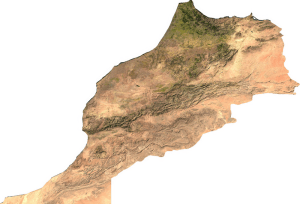
A central consideration related to prehistoric human settlement of coastal areas worldwide has revolved around climate change. In a paper published online on October 3 in the Journal of Human Evolution, Emilie Campmas of the Université de Bordeaux and colleagues suggest that early modern humans who occupied caves in the Témara region near the coast of Northern Morocco came and went, at least in terms of the intensity of their occupation, in correlation with major shifts in the climate of the region.
“The study area was selected for two main reasons,” write the study authors in their report abstract. “First, it contains numerous caves with Upper Pleistocene deposits, which have yielded remains of anatomically modern humans in association with Aterian and Iberomaurusian artifacts. Second, these caves are currently located on the shore, thus this region is particularly sensitive to major climate change and sea level fluctuations.”*
The researchers conducted a diachronic taphonomic study of the faunal remains recovered from two sites in the Témara region, the El Harhoura 2 and El Mnasra caves. Their study showed alternating human and non-human predator occupations of the sites. They found that the lower layers of the El Mnasra Cave, dating to Oxygen Isotope Stage (OIS) 5 [between 80,000 and 130,000 years ago], yielded the remains of a diverse range of ungulates and that at least some of the remains featured significant “anthropogenic impact marks”, or cut-marks due to human activity, such as the application of stone cutting tools. This evidence was associated with mollusk shells, Nassarius shell beads, hearths, lithics, bone tools, and pigments. They also found that faunal remains in the upper layers dating to later periods in the El Harhoura 2 and El Mnasra caves were predominantly gazelles, showing significant evidence of non-human carnivore activities, “such as tooth marks, numerous semi-digested bones and coprolites” along with significantly fewer anthropogenic signatures (cut marks caused by humans and burnt bones). Moreover, analysis of the lithic evidence at El Harhoura 2 dated to the later periods indicated a less intensive human occupation. “The ‘intensive’ human occupations date to OIS 5 and could have taken place during wet periods in connection with high sea levels, which allowed the exploitation of shellfish in this area,” write the study authors. “‘Non-intensive’ human occupations generally correspond to arid periods and lower sea levels, during which the Témara area was further inland and may have been less attractive to humans”.*
The study may have some implications for understanding or reinforcing the influence of climate change or fluctuations in the scientific modeling of ancient coastal human settlements or migrations/movements in other parts of the world.
___________________________________________
*Emilie Campmas, Patrick Michel, Sandrine Costamagno, Fethi Amani, Emmanuelle Stoetzel, Roland Nespoulet, Mohamed Abdeljalil El Hajraoui, Were Upper Pleistocene human/non-human predator occupations at the Témara caves (El Harhoura 2 and El Mnasra, Morocco) influenced by climate change?, Journal of Human Evolution, 2014, DOI: 10.1016/j.jhevol.2014.08.008
Cover Photo, Top Left: Satellite image of Morocco, Wikimedia Commons
___________________________________________
Travel and learn with Far Horizons.
Read about the most fascinating discoveries with a premium subscription to Popular Archaeology Magazine. Find out what Popular Archaeology Magazine is all about. AND MORE:
On the go? Get the smartphone version of Popular Archaeology as an app or as an ebook.
Popular Archaeology’s annual Discovery Edition eBook is a selection of the best stories published in Popular Archaeology Magazine in past issues, with an emphasis on some of the most significant, groundbreaking, or fascinating discoveries in the fields of archaeology and paleoanthropology and related fields. At least some of the articles have been updated or revised specifically for the Discovery edition. We can confidently say that there is no other single issue of an archaeology-related magazine, paper print or online, that contains as much major feature article content as this one. The latest issue, volume 2, has just been released. Go to the Discovery edition page for more information.






